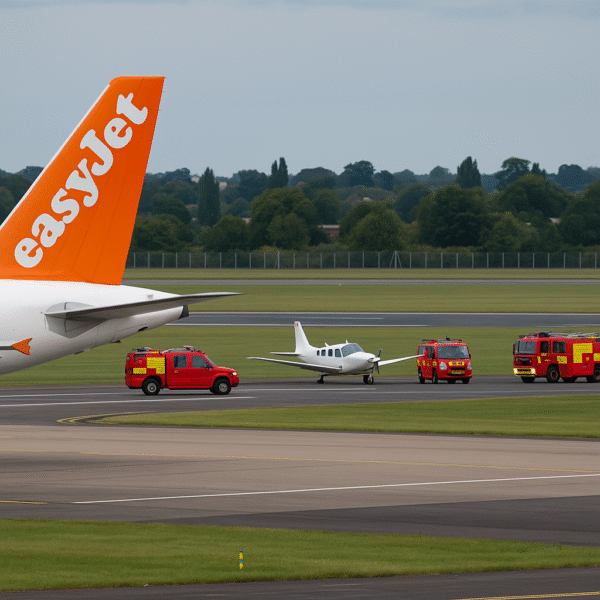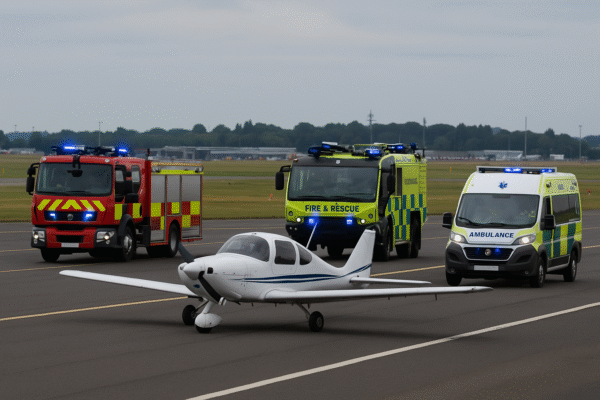On the afternoon of August 6, 2025, Birmingham Airport experienced significant operational disruption following the emergency landing of a light aircraft. The runway was immediately closed, all flights were temporarily suspended, and one individual suffered minor injuries. The incident led to widespread delays, diverted aircraft, and frustration among travelers, underlining the vulnerability of even the most robust travel hubs during unexpected aviation events.
Incident Overview: Emergency Response and Grounded Flights
At approximately 1:50 PM local time, a small propeller-driven aircraft reported mechanical issues—most notably a failure in its landing gear. This prompted an emergency landing that forced Birmingham Airport authorities to immediately shut down the runway. Emergency services, including fire crews and medical responders, were rapidly dispatched to the scene.
Eyewitnesses and social media images depicted the aircraft stationary on the tarmac, encircled by emergency vehicles. The seriousness of the event prompted swift action from airport staff, who suspended flight operations to prioritize safety. The final departure before the shutdown was an easyJet flight bound for Tenerife, while the last arrival was a Ryanair service from Perpignan.
Travel Disruptions and Passenger Impact
As flights were grounded, passengers were urged to verify their flight statuses via official airline channels. For many, the situation was marked by confusion and limited access to real-time information. Birmingham Airport’s official website temporarily went offline, exacerbating communication gaps between passengers and airlines.
Travelers like Paul and Corinne, visiting from Zurich, were en route to Wales for a short family trip. With their return flight now uncertain and business commitments looming, the disruption caused major concern. Meanwhile, others like Camile Monteleone, scheduled to return to Barcelona, found themselves stuck with no clarity on rescheduling or cancellations.
Despite multiple airline apps and contact centers being available, the lack of centralized updates left many passengers scrambling for alternative solutions. Airports Council International (ACI) Europe emphasizes the importance of robust contingency communications in such emergencies—something this incident highlighted as a key weakness.
Flight Diversions and Delayed Recovery
Numerous inbound flights were rerouted to nearby airports, including East Midlands, Manchester, and London Luton. Airlines like Jet2, TUI, and Ryanair began notifying customers via SMS and mobile apps, yet on-ground passengers expressed dissatisfaction with the pace of updates.
According to the Civil Aviation Authority (CAA), when emergency runway closures occur, airport protocols include redirecting aircraft and initiating a full safety inspection before resuming operations. Birmingham Airport confirmed through a statement that operations were expected to gradually resume by 8 PM, pending clearance from emergency services and engineering teams.
Economic and Operational Implications
The incident is expected to have a ripple effect across the UK’s broader aviation network. Birmingham Airport serves over 12 million passengers annually and is a vital hub for the Midlands region. Disruptions of this scale not only strain the resources of local airlines but also affect connecting flights globally.
Staff at the airport—including ground handling teams, security personnel, and airline agents—faced significant operational stress in managing the backlog. According to Birmingham Airport’s latest operational report, the facility has invested in resilience planning, but incidents like this emphasize the importance of continuous improvements to crisis response protocols.
Communication Breakdown: A Digital Wake-Up Call
This event also served as a reminder of the crucial role digital infrastructure plays in tourism and travel. As the airport’s website and live tracking systems temporarily went down, passengers were left relying on third-party apps or airline desks, which were overwhelmed with inquiries.
Travel technology experts suggest investing in decentralized communication platforms—such as WhatsApp chatbots or automated airport notification systems—that function independently of main websites. These systems could ensure timely updates in future crises, particularly during flight cancellations, rebookings, or airport closures.
Steps Toward Normalcy and Passenger Assistance
By the evening, Birmingham Airport confirmed that the emergency had been resolved without fatalities, and the runway had been cleared. Flights gradually resumed, although delays and rebookings continued well into the night. Passengers who missed connections or were left stranded overnight were advised to seek accommodations, with some airlines offering hotel vouchers and meal allowances in line with UK and EU passenger rights regulations.
The UK Government’s Department for Transport (DfT) and Birmingham Airport management are expected to conduct a joint review of the emergency landing and its subsequent handling. Aviation Minister Harriet Jones emphasized the importance of passenger safety and reiterated the government’s commitment to strengthening emergency preparedness across all major UK airports.
Looking Ahead: Lessons for UK Air Travel
This incident underscores the fragility of air travel in the face of technical failures and the necessity for multi-tiered crisis planning. For travelers, it serves as a reminder to stay informed, use multiple platforms for updates, and remain flexible when unexpected changes occur.
For Birmingham Airport, this emergency landing is likely to prompt a review of digital infrastructure, emergency response speed, and passenger care protocols. As one of the UK’s key travel hubs, ensuring resilience in the face of aviation incidents is essential—not just for operational continuity, but for maintaining public trust.
Tourists planning to visit the West Midlands or fly through Birmingham Airport in the coming weeks are advised to check with their airlines and monitor official travel alerts, especially as the airport works through the backlog and adjusts schedules.
For more travel news like this, keep reading Global Travel Wire


















